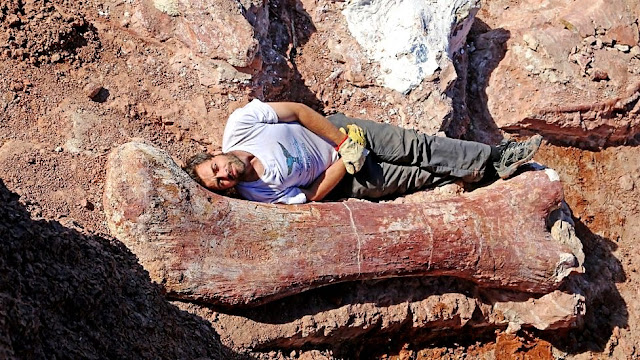New Species of Dinosaur Is the Largest Land Animal to Ever Walk the Earth
 |
| Diego Pol lying by large femur thigh bone fossil of thenew species find, |
One hundred million years ago, a colossal creature the size of a 737 thundered through the forests of South America, picking trees clean with its head extended five stories in the air and sending ferocious T. rex-like therapods scattering like mice below its trunk-sized legs.
It’s the largest dinosaur ever found — a titanosaur so huge that its skeleton can’t even fit into a single room in its home at the American Museum of Natural History.
Scientists this week unveiled their first study on the ancient beast alongside its new, official name, Patagotitan mayorum, or, The Giant from Patagonia.
Astoundingly, the Big Apple’s biggest resident wasn’t even fully grown when it died (scientists don’t know if it was male or female) — and an even more whopping cousin could be waiting to be uncovered, experts said Wednesday.
“This animal [hadn’t] stopped growing at the time of death,” said Diego Pol, an Argentina paleontologist who helped dig it up.
The moniker Patagotitan mayorum is a nod to its place of discovery — the remains were found in the Patagonian region of Argentina in 2012, on a farm belonging to the Mayo family in La Flecha, about 800 miles south of Buenos Aires. “A rancher in the middle of Patagonia was looking for sheep on his own ranch. He saw something on the ground that caught his attention. It was the tip of the leg bone that was sticking out of a rock,” Pol said.
Stunned sheep farmers notified a local museum and Pol and his team spent the next few years excavating seven partial skeletons and more than 150 bones from the site.
A photo from the dig shows one team member lying beside a single P. mayorum femur bone— it’s larger than he is.
The scientists reproduced the skeleton in 3-D models, but the specimen was too large to fit in any local museum, Pol said, so they sent a fiberglass cast to New York last year.
It has been welcoming visitors to the museum’s dinosaur floor ever since — literally, because its massive skull extends all the way out into the elevator bay.
“[It’s] probably one of the world’s great selfie spots,” said John Flynn, the museum’s curator of fossil mammals.
Now scientists are piecing together a picture of how the P. mayorum lived.
They believe the supersized sauropod roamed the forested flood plains of Patagonia — which extends to the southernmost end of Argentina and Chile — during the Late Cretacious period.
Titanosaur is a relative of the Brontosaurus, but twice as long and four times as heavy.
The gargantuan animals lived among the kinds of predators that terrorize the nightmares of any kid who’s seen “Jurassic Park,” but were so much larger, they made the meat-eaters look like pip squeaks, researchers say.
“[They’d] look like dwarfs when you put them against one of these giant titanosaurs,” Pol told the Associated Press. “It’s like when you put an elephant by a lion.”
The only chance a therapod had of sinking its teeth into an adult titanosaur was feasting on its carcass after it kicked the bucket.
“There were some very large carnivorous dinosaurs that would prey on the young and sick ones. They’re opportunistic feeders,” said Flynn.
But P. mayorum was a gentle giant. The species moved slowly because of their size and put most of their energy into eating enough to stay alive.
One Natural History guide estimates the titanosaur would have consumed more than 100,000 calories a day — about 177 Big Macs — by using their long necks to munch on leaves, ferns and seeds.
 |
| The dinosaur is a new species and one of the largest dinosaurs ever discovered. |
“I don’t think they were scary at all. They were probably massive, big, slow-moving animals,” Pol said. “Getting up. Walking around. Trying to run. It’s really challenging for large animals.”
Incredibly, their eggs were probably around the size of a grapefruit, the scientists said. But unlike human babies, which take six months to double in size, newborn titanosaurs doubled their weight in two weeks — and again in a month.
At 1 year old, a titanosaur would have weighed 1 ton — the same as a fully grown polar bear.
And how did such hulking creatures get down and dirty to reproduce in the first place?
“Very carefully,” Flynn quipped.
Even though archeologists may still discover larger titanosaurs than the one now residing on the Upper West Side, we may never find a larger species, as scientists believe the 76-ton titanosaur is about as big as creatures can get.
“These may be approaching the limit of the possible size of how large you can get if you live on land,” said Flynn.
But wide-eyed kids who visited the museum on Wednesday to meet the newly-named dino said this one was scary enough.
“I was shocked. I was like, ‘That is humongous!’ ” said 9-year-old Rhyan, who was visiting from New Jersey and estimated the titanosaur is around the size of 30 giraffes and elephants combined.
Fellow pint-sized paleontologist Liz, 11, disagreed with that conclusion.
“It was as big as 500 giraffes,” the Long Island youngster declared.
“I didn’t think it would be that big!”